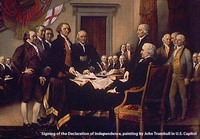Login form
Declaration of Independence

In the mid-1700s, many British colonists in America were angry at King George III. He had imposed a number of taxes on them, demanding more and more money. The colonists felt that they were not being supported or listened to by the British government. Finally, the colonists had enough. In 1776, they wrote up a document that announced they were forming a new nation. They didn’t want to be part of Great Britain anymore.
This document was the Declaration of Independence. It fueled a long and bloody war, the American Revolution (1775-1783). The document resulted in the birth of the United States of America.
TAXES STARTED THE TROUBLES
Angry mobs protested King George’s taxes on tea, paper, and many other items. People avoided the taxes by refusing to buy British goods. They even attacked the tax collectors. In 1773, some citizens in Boston, Massachusetts, protested the tax on tea by dumping 342 chests of British tea into Boston Harbor.
THE FIGHTING STARTS
Bad feelings hardened both sides. The American Revolution broke out on April 19, 1775, when British soldiers opened fire on colonists at Lexington and Concord in Massachusetts. The fighting quickly spread.
Delegates from the 13 colonies gathered in Philadelphia, Pennsylvania, to discuss what to do. In July 1775, King George refused to read the Olive Branch Petition, a plea from the colonies for peace. War was coming.
PAINE SHOWS THE WAY
In January 1776, colonist Thomas Paine wrote a 50-page pamphlet called Common Sense. Americans bought Paine’s pamphlet as fast as it flew off the printing presses! Common Sense included reasons why the colonies didn’t need Great Britain anymore.
LEE PROPOSES INDEPENDENCE
On June 7, 1776, Richard Henry Lee of Virginia asked the colonial government to vote on a resolution for independence. John Adams of Massachusetts, later a U.S. president, jumped to his feet and supported Lee's resolution.
The governing body formed a committee to write a statement of independence. Adams, Thomas Jefferson, Benjamin Franklin, Roger Sherman, and Robert Livingston agreed to work on the statement. The committee left most of the writing to the tall, red-haired delegate from Virginia, Thomas Jefferson.
THE DECLARATION OF INDEPENDENCE
Jefferson divided the document into three sections. The first part established the natural rights of all people. “All men are created equal,” Jefferson wrote. People had the basic right to “life, liberty, and the pursuit of happiness.” Governments ruled only with the consent of the people.
The second section listed the reasons why the colonies felt they had to declare independence. Jefferson described the ways that King George had treated the colonies unfairly.
The last part formally stated that the colonies wanted to cut all political ties with Great Britain. Jefferson declared the colonies to be “free and independent states.”
HOW WAS THE DECLARATION PASSED?
Not everyone in the colonies agreed on the question of independence. Delegates like John Dickinson of Pennsylvania feared a war with the powerful British army. The delegates from some colonies split over how to vote. Delegate Caesar Rodney of Delaware rode through the night to Philadelphia to swing the Delaware vote to yes for independence. On July 2, 1776, the delegates approved the Declaration of Independence. It was signed two days later.
Newspapers and printers rushed the news to the public, reprinting the words of the declaration. People lit bonfires and rang church bells. But a long war lay ahead before America’s independence became a fact.
AN INSPIRATIONAL MESSAGE
Since 1776, Jefferson's words have inspired people in the United States and around the world. Americans later adopted those same words in the fight against slavery in the United States. Elizabeth Cady Stanton used the Declaration of Independence for a model when she fought for women's rights in the mid-1800s. Civil rights leaders in the 1960s also recalled Jefferson’s promise of equality in their fight for freedom.
Today, the National Archives in Washington, D.C., preserves the original copy of the Declaration of Independence. It rests alongside the nation's other founding documents, the Constitution and the Bill of Rights.
Source: Microsoft ® Encarta

